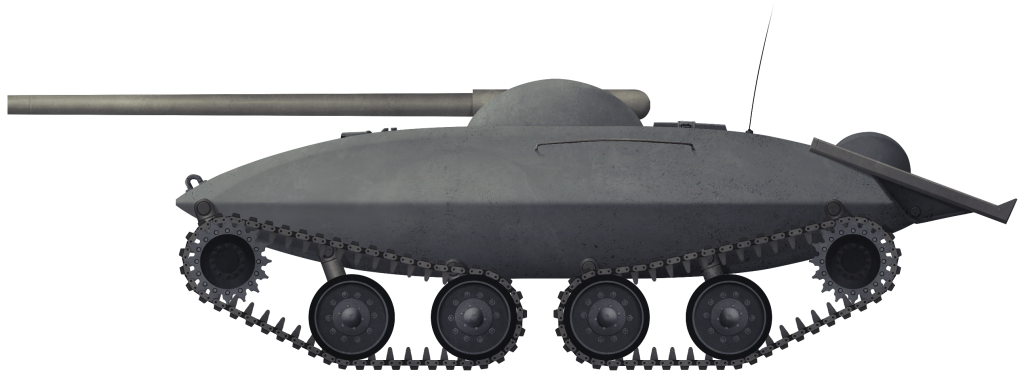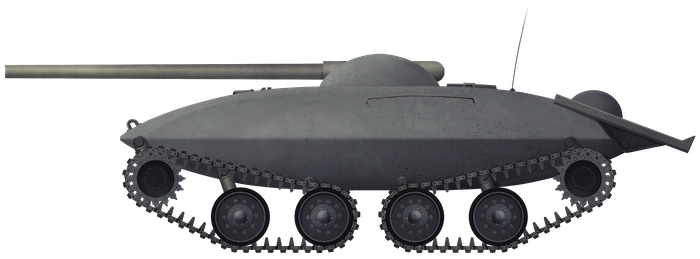 United States of America (1962-1963)
United States of America (1962-1963)
Main Battle Tank – None Built
By 1962, the 105 mm Gun Tank M60 was still a new tank in service with the US Army but, just like any current system, was already being considered for future replacement, redevelopment, and upgrading. The latest generation of Soviet tanks were well armed and armored, and much smaller than their American counterparts. A new tank would be needed to deal with this increasingly dangerous threat. During the height of the Cold War in 1962, the Armor Association of the United States Army held an open competition for the design of a new tank. Of the designs submitted, some were clearly better thought-out and practical in terms of production, cost, and combat effectiveness than others.
Nonetheless, the competition formed part of one means by which the US Army could assess new and novel ideas for the potential next generation of tanks. One such tank, perhaps the most outlandish of the top four finishers, came from the fertile mind of Everett Philip Ridlon of Hibbing, Minnesota. Ridlon, an electrical engineer by trade. He submitted a quad-track tank with a crewless turret propelled by a hybrid-drive system based on the M60.

Suspension
Probably the most obvious thing about Ridlon’s design is the suspension. Six wheels on each side divided into groups of three with a strong angling at the front and back respectively. Assuming the raised wheel at the front of the lead unit and rear of the rear-most unit were the drive sprockets this provided a strong degree of redundancy in the design so that should one unit become damaged by enemy fire or a land mine or accident, the vehicle would not be immobilised. Each wheel was held on a single arm providing a good degree of movement and is reminiscent of the suspension arms of the M60. If it was just like those on the M60, then the arms would be hydraulically damped in their movement.

Hull
The design of this vehicle was not going to need a new tank hull, as Ridlon simply planned to reuse the lower hulls from the M60. He proposed stripping out of the original drive components and fitting a new engine and the motors. On each side in the middle, where the two track units were closest to each other, the road wheels would be on the ground, creating a large empty space above them. This meant that the new upper hull of the M60 donor tank was going to need to bulge out across the side to improve the ballistic protection in that area.
Within the hull would sit the two crew along with the myriad of engines and motors proposed. In amongst all of this would be compartmentalised storage for fuel, compressed air, hydraulic fluid, water, fire extinguishers, and other items which were seen as being able to add to the protective structures around the crew.

Armor
The lower hull would be that of an M60, but the upper half would be remade to feature a large curved section across the top half bulging out at the sides to make use of the low section above the ends of both track units on each side. Further, Ridlon wanted the armor to be made in sections so that, as it was hit by enemy shells, the outer sections would break away on impact. To accomplish this, he wanted the outer sections of the armor to be made ‘soft’, with ‘hard’ armor on the inside, in what he describes as a “live” system. Further, he stated “the outer armor is composed of ribbed interlocking plates which give greater depth of armor and less weight as well as catch the projectile higher on the sides and thus disperse impact energy over a larger surface area”. The whole plan was not practical in that sense, but it could be considered as modular as each damaged section could at least be replaced.
Firepower
The drawing of the turret and main armament is almost comically poor, with an impossibly small turret described as a ball-type turret. In this turret were to be two machine guns and either an automatic cannon or an automated one. The turret, as drawn, certainly appears far too small to accommodate any men but, if it is considered to be a remote turret, and a ball-type turret at that, it seems a little less ridiculous. Those turret-mounted weapons were not the end of the arsenal the tank would carry, as Ridlon also proposed rocket tubes should be placed in the upper hull, capable of attacking ground or airborne targets.
Automotive
Ridlon, somewhat preciently for a US Main Battle Tank, proposed the use of a very small ‘gas turbine’, that is, a turbine-type engine running on petrol. This engine was not to directly drive the tank though, but was to drive a series of small high-speed homopolar generators. Each of these generators would be spread around the vehicle to minimize the chance of a single one becoming damaged and incapacitating the vehicle. Ridlon envisaged this system being duplicated for all military vehicles, as the humble Jeep would need just a pair of these small generators, a truck three and eight for a tank. Ridlon proposed eight small turbines working together to deliver power to thirty-two motors which powered the four sprockets which drove the tracks. The idea was that, by increasing the number of possible drive options, it would be impossible to be crippled by the loss of any one drive unit, motor or generator. The chances of all of those elements being made to work without something breaking seems highly optimistic even though it is the best part of his design considering elements of protective redundancy in the drive units to avoid being crippled and vulnerable to enemy fire. Rearranging the automotive elements of the tank to multiple small motors and generators would have made significant changes to the internal layout possible but that was beyond Ridlon’s skills as a designer, which perhaps explains why the drawing was so poor and the ideas on armor so poorly conceived.
Conclusion
Ridlon’s design took third place in the Armor Association’s competition, behind the Forsyth brothers’ coupled-tank and Eischen’s MBT, yet is drawn and described very crudely. The design appears utterly impractical with multiple complex systems, yet was held in high regard by the Armor judges. The question is why?
Perhaps it was a combination of novelties of the ball unmanned ball turret, the hybrid drive, the compartmentalization or some or all of those, but whereas the Forsyth design was a competent and well-thought-through design, this vehicle was simply impractical and an example of fantastical thinking for the time. There was no likelihood this vehicle would ever have been built and its inclusion in third place seems surprising given other better thought out designs. Ridlon did better than his tank design did, by 1970 he was teaching at a technical college before retiring in 1992. He died of lung cancer in 2011.

Illustration of Ridlon’s Main Battle Tank, based on his original sketch, produced by Andrei Kirushkin, funded by our Patreon campaign.
Specifications |
|
| Crew | 2 |
| Propulsion | Petrol-Electric (8 Petrol turbine driving 32 high speed homopolar generators) |
| Armament | 2 machine guns, cannon, surface to air/ground missiles |
Sources
Armor Magazine January-February 1963
Hibbing Daily Tribune, 12th June 2011 ‘Everett Philip ‘Babe’ Ridlon


One reply on “Ridlon’s Main Battle Tank”
Where would the spent shell casing go once the gun was fired? Did they fall back into the tank or was there some system of ejecting them once fired?